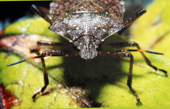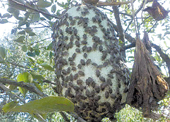
How to protect homes from the Asian Stink Bug?
By Gvantsa Gabekhadze
Monday, October 16
Georgia’s National Disease Control Centre and the Food Agency have jointly released recommendations on how to protect homes from the Asian Stink Bug. The insect, which inflicted widespread damage to Samegrelo in west Georgia, has been recently spotted in Tbilisi.
The insect creates no threat for human health, but is very dangerous for agricultural produce and creates worry when spotted inside people’s homes.
They seek warmth in order to survive cold winter days.
The recommendations offered by the agencies read:
Use window and door nets.
Remove plants from homes as they are particularly attractive for the bug.
Try to close each crack in the house and any such entry for the bug.
If your house has a fireplace, close the chimney.
If you spot the bug at home, you can use a vacuum cleaner. However, remember that this may make the vacuum cleaner smell bad.
You can trap the bug using a bowl with sudsy water. Place a lamp over the bowl to attack the insect.
Aerosols can be used to make insects come out from cracks. However, as a long-term solution, this method is less effective.
Georgia’s Ministry of Agriculture has been trying to eliminate the bug for several months through the use of chemicals.
The Ministry stresses the importance of people’s efforts in the fight.
Halyomorphahalys, also known as the brown marmorated stink bug (BMSB), or simply the stink bug, is an insect in the family Pentatomidae that is native to China, Japan, the Koreas, and Taiwan.
It was accidentally introduced into the United States, with the first specimen being collected in September 1998.
The brown marmorated stink bug is considered to be an agricultural pest, and by 2010–2011, had become a season-long pest in U.S. orchards.
Currently it is widespread in Europe, and recently has been found in South America.


